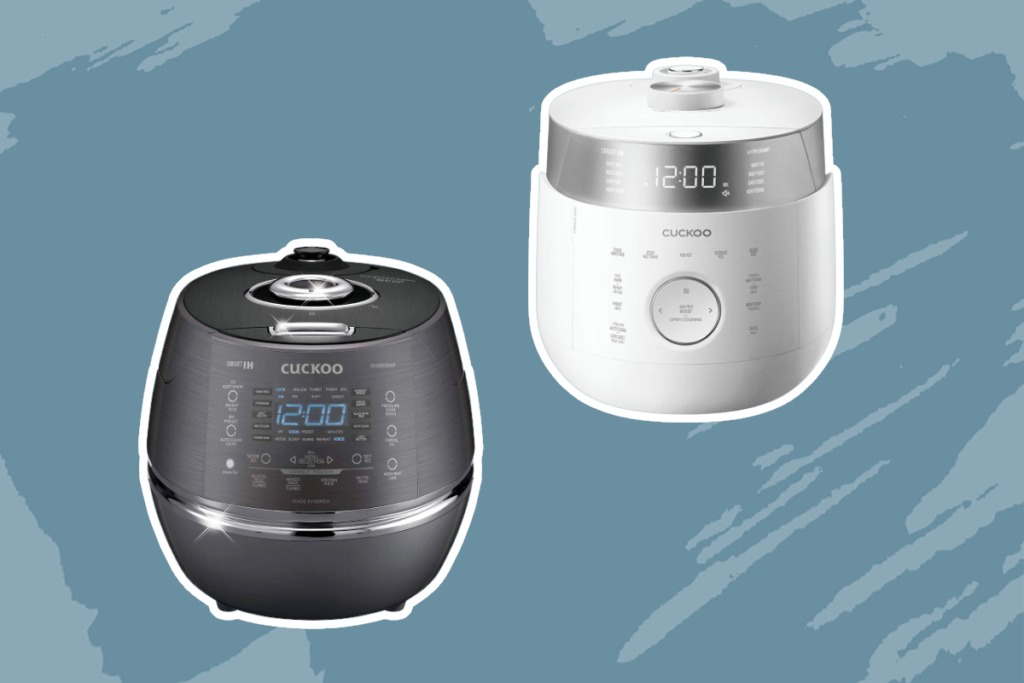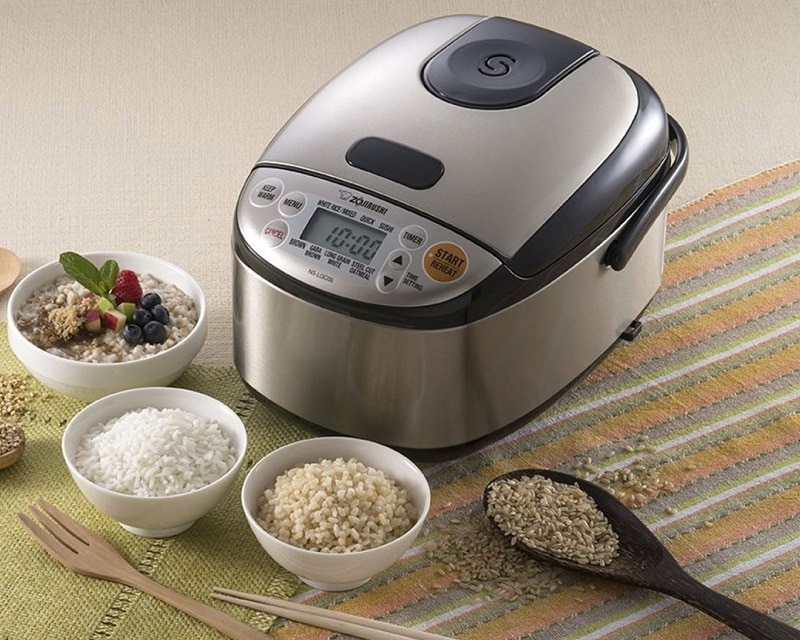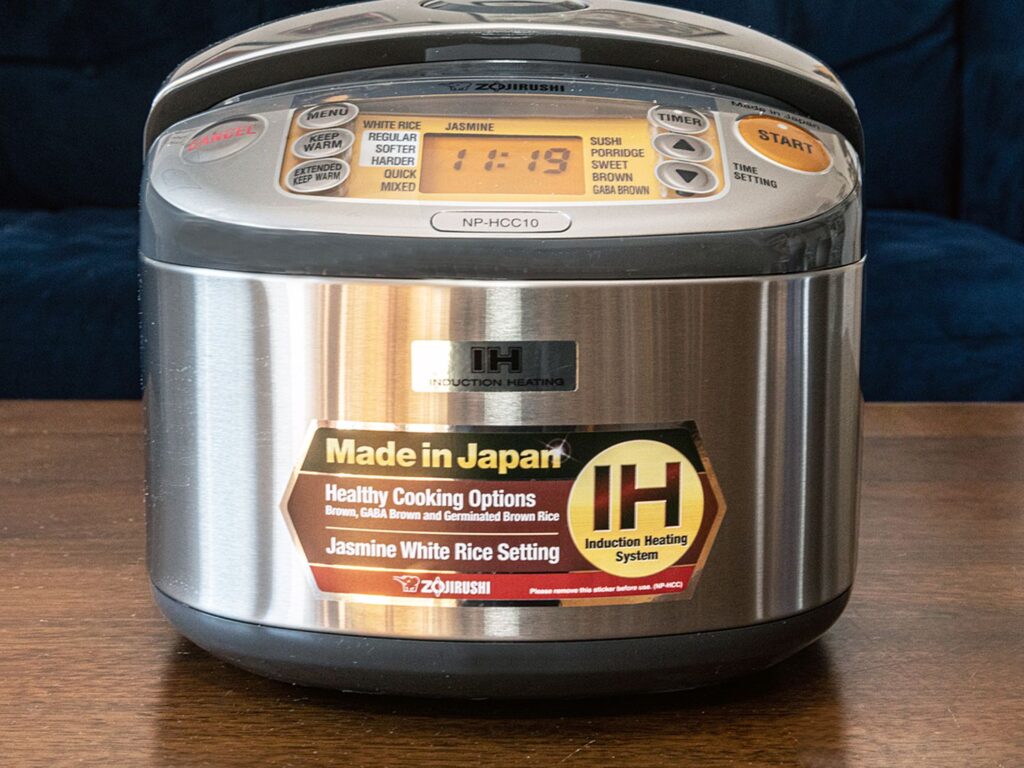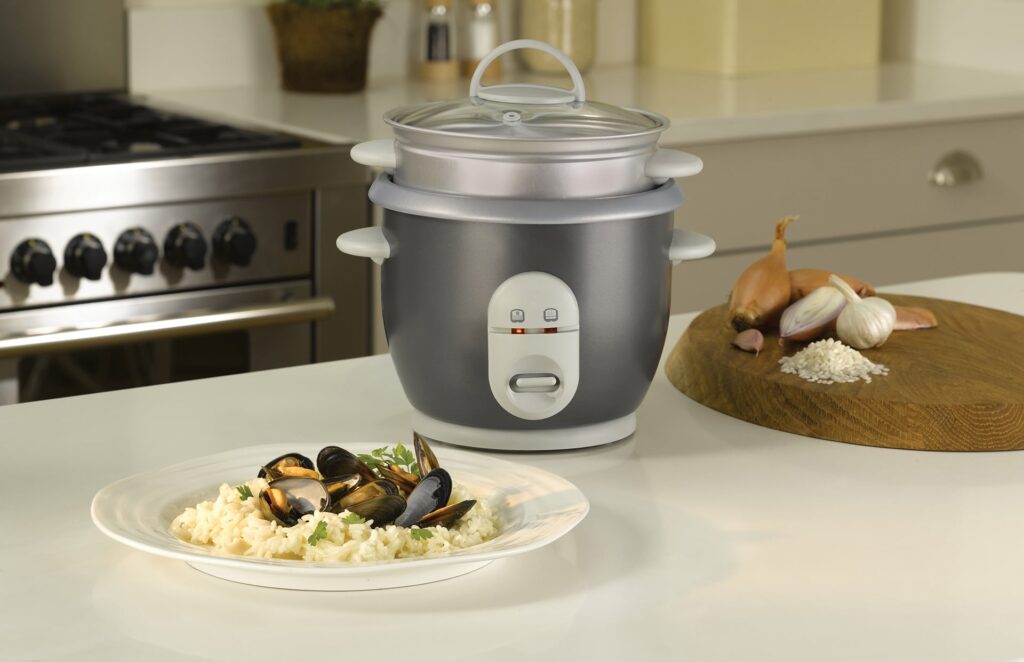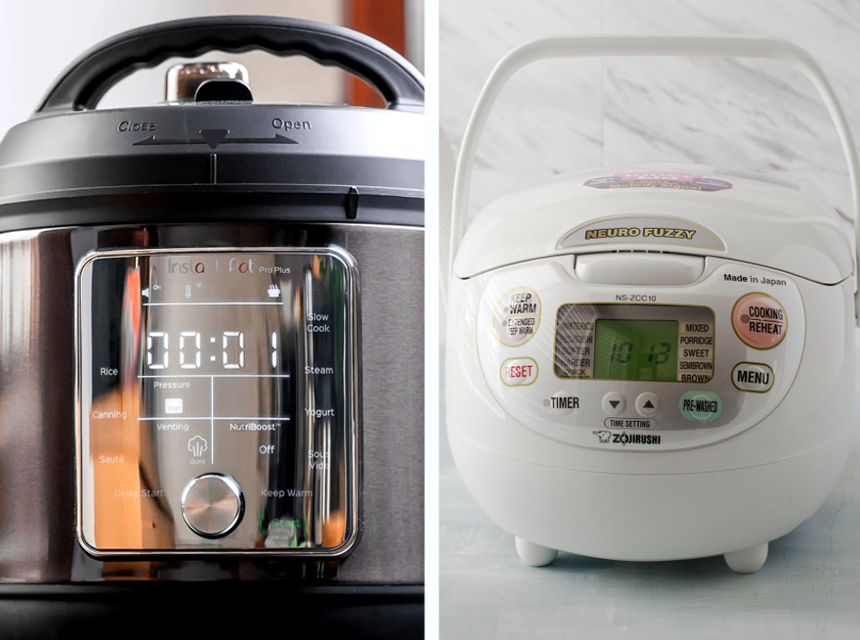Our daily lives are becoming increasingly complex, leaving us almost no time to make meals. Fortunately, we have a variety of home gadgets at our disposal, such as pressure cookers and rice cookers, to assist us in doing the process quickly. While they appear similar and have common characteristics acting against and for them, they are pretty different and offer unique advantages.
Which one suits you the best? Well, this pressure cooker vs rice cooker article will help you with their differences that will help you make a more informed choice. Some individuals argue that it is a waste of resources to purchase a rice cooker. Others think differently. It’s all subjective! Enough of the arguments. Let both gadgets speak for themselves. Shall we?
Pressure cookers are useful kitchen tools that use steam pressure to prepare meals quickly. In comparison to dry air, steam is an excellent heat conductor. However, with increasing pressure, steam may gradually climb to its highest temperature, allowing meals to cook more quickly. As a result, steam pressure is more effective and quicker than boiling, baking, or steaming.
You must understand the principles of water dynamics and steam generation to comprehend better how pressure cookers operate. Since vapor and boiling water maintain a constant temperature level regardless of how long they are left to boil, the rate or pace at which foods may cook is constrained after the water hits 212° F or 100°C and begins to boil.
Pressure cookers work to raise surrounding pressure, which traps steam in the enclosed space, to raise the temperature of the water as it turns to steam. As a result, pressure cookers function by sealing off enclosed compartments with steam using an airtight sealing cover.
Why is a pressure cooker preferable to a rice cooker, particularly for cooking rice? Here are various advantages of using a pressure cooker.
Pressure cookers make meals more quickly than most appliances because the airtight cover of the pressure cooker locks in place perfectly to trap the heat by using steam and external pressure to warm up the internal environment.
Your food will cook more quickly than it would with other techniques because of the steam and pressure that surround it. Even time-consuming foods like fresh beans may be prepared and soft in less than an hour.
Try to accomplish it using a rice cooker! This is unquestionably the gadget for you if you’re impatient and prefer to dine right away after turning the cooker on.
One of the greatest cooking devices for retaining flavor is the pressure cooker. They operate by keeping moisture within, preserving the contents’ original flavor and taste. Since a pressure cooker can seal in flavor, you’ll use less seasoning because the cooked food will be healthier.
The fact that pressure cookers’ lids securely lock the contents makes them safer than most kitchen tools.
Contrary to frying pans or boiling pots, which, whether open or covered, might spill or spray their contents if handled improperly and result in severe burns, pressure cookers do not cause such harm.
As one of the best cooking gadgets for conserving energy, pressure cookers are known for their shorter cooking times.
They are energy-efficient cooking tools because they can quickly prepare foods that often take a long time.
They not only help you save energy but also time since, unlike other cooking techniques, you won’t need to spend several hours making meals.
Pressure cookers are incredibly versatile since they can cook tougher foods like beans, meat, and brown rice in much less time.
When it comes to dishes like meat and roasts that need to be sufficiently tenderized, a pressure cooker is a very handy appliance. With it, you can prepare a broad range of meals, including soft-boiled eggs, vegetables, stews, and cereals.
Although having a pressure cooker has many benefits, there are some drawbacks. Here are some of the downsides of using a pressure cooker.
Since the pressure within a pressure cooker is locked, it has to be released to open the cover securely.
You can’t inspect or stir your meal since you risk losing the pent-up pressure and starting over. Because of this, you cannot season or stir while cooking in a pressure cooker, unlike on a stovetop.
Due to the possibility of unintentional steam escape, pressure cookers require frequent supervision as the food cooks, as opposed to crock pots, which are perfect for hands-off food preparation.
Therefore, most makers of pressure cookers advise against stepping out of your home while a pressure cooker is running, particularly before the cooker reaches its maximum pressure.
Since pressure cookers rely on boiling water and pressure, altitude significantly impacts their performance. The typical water boiling point at sea level is 212° F or 100°C. Since this boiling point drops to 208° F or 98°C at 2000 feet above sea level, the dynamics of the pressure cooker do, however, tend to change as you ascend.
When you are over 2,500 feet, atmospheric pressure decreases so that cooking may take longer. You must be prepared to tweak your cooking while using pressure cookers because of the lowered pressure and the lower boiling points at higher altitudes.
It would be best if you took your time to understand how a pressure cooker functions, particularly while making various dishes. More liquid stays within the pot when using a pressure cooker since there is less evaporation than in appliances like rice cookers.
As a result, to prevent overcooking food, you need to pay close attention to the total amount of water.
Electric countertop machines called rice cookers are made to cook different kinds of rice perfectly mechanically. They have several characteristics of slow cookers, such as a thermometer to regulate and control the internal temperature, a cooking pot, strong handles, a tight cover, and a basic set of controls.
Most of the best rice cookers have special spoons that can scoop the rice out of the pot without scratching the interior non-stick covering.
If you would like to learn more about rice cookers or consider getting one, you should check out our list of the best rice cookers.
Use a rice cooker as directed. Add rice and water in a 2:1 ratio to the inner dish. Turning on the appliance activates the thermostat and heating components underneath the bowl, which are generally comprised of efficient heat conductors and permit the water to turn into steam, and so cook the rice.
The heat source within the cooker is responsible for heating the dish, and the thermostat controls the heat by monitoring the bowl’s temperature. When the temperature of the rice cooker bowl’s bottom hits 212° F/100°C, the water begins to steam.
The rice becomes soft and supple after absorbing the steam. Until the rice is completely cooked, the inner temperatures will be held constant. Rice cooked in a rice cooker always turns out perfectly without burning or becoming mushy since the device cannot boil food over 212° F/100°C.
Some of these principles also apply to sticky rice; if you would like to know more, read our article on how to make sticky rice in a rice cooker.
You may want to know some of the benefits of rice cookers if you usually cook large quantities of rice. They could be useful if you’re cooking a complex dinner.
With fewer settings and controls than other countertop appliances, rice cookers are often simple to operate, so you don’t have to be a professional to prepare a tasty rice dish.
All you must do to prepare rice in a rice cooker is to add the appropriate amounts of rice and water, cover it, and turn the appliance on. The cooker will notify you once the rice is done, which helps reduce a considerable amount of the guesswork involved in making rice.
Rice cookers are commonly used today while preparing the ideal rice since almost all contemporary models include an automatic shut-off mechanism that eliminates overcooking.
The temperature increases as soon as the rice has absorbed all the water in the dish. The cooker recognizes the change using its built-in thermal sensors and either switches to a warming cycle or shuts off automatically.
You already know that rice is done cooking when all of the water needed to prepare it has been absorbed and evaporated. When they notice that the internal moisture is almost depleted, rice cookers are made to lower their temperature automatically. This avoids overheating and burning, in addition to preventing dry rice.
Since pressure cookers are made to cook various foods, not simply those that call for nearly complete fluid evaporation, they aren’t equipped with this component. This implies that they will require ongoing supervision, unlike rice cookers.
Rice is best served hot, as is obvious, and a rice cooker enables you to achieve just that. Many rice cooker appliances are equipped with cutting-edge features that not only cook the rice to perfection but also let you keep it warm while preparing other dishes. Given that most cooking appliances lack this special capability, rice cookers have an advantage.
Although rice cookers are excellent, they have several disadvantages that may discourage some users from using them.
In this regard, pressure cookers outperform. A rice cooker is excellent for cooking rice as you go on with your daily activities, but that’s all. In contrast, pressure cookers are incredibly adaptable and can make various foods.
Other foods can also be cooked in a rice cooker, but the results won’t be as nice.
Rice cookers certainly cook slowly! Another benefit of pressure cookers over rice cookers is the time it takes for your food to be ready.
The former employs the temperature inside it to hasten the cooking process, while the latter depends on heat and steam. A rice cooker may not help if you’re often on the go and require fast food.
It is not guaranteed that the rice you cook in a rice cooker will come out exactly how you want it to. Rice can be burnt (particularly those at the bottom) if water and rice are not combined in the correct amounts.
You must precisely measure the water and rice in your rice cooker for it to deliver the much-desired ideal rice.
This is important if you are cooking sushi rice. If you love this article, you should check out our list of the best sushi rice cookers.
Since non-stick materials are used in most rice cooker dishes, owners must use certain tools to remove the rice and protect the coating.
The bowl’s surface can get damaged if you use metal utensils, reducing the appliance’s effectiveness.
If there isn’t enough room in the kitchen for one more appliance or if there is a strict spending limit, it could be challenging to decide between a top-of-the-line pressure cooker and a high-quality rice cooker. Although they may appear similar, pressure cookers and rice cookers have different uses.
Pressure cookers require some getting used to while being simple to operate. You need to learn how components like the cover latch, vent pipe, and pressure regulator function.
As a general guideline, before shutting the lid, examine the vent pipe to make sure it’s clear. You should read the owner’s instructions thoroughly before operating a pressure cooker because of the dangers of steam, heat, and high pressure.
Since rice cookers are primarily used for cooking rice, they don’t have many functions. In contrast to a pressure cooker, which often has more controls and settings, the menu is generally simple.
Let’s go over some in-depth comparisons between these two devices in the next section.
Let’s look at the differences between a pressure cooker and a rice cooker now that we know their benefits and drawbacks.
When the seal is secured and shut, the rubber lining of pressure cooker lids helps to trap steam. Cooking is made quicker and more effectively because of the rubber lining’s ability to regulate the pressure within the cooker. Users may determine how much food is being pressure cooked within the pot using the pressure sensor.
Instead of using both pressure and steam to cook, a rice cooker uses only steam to cook vegetables and rice. Rice cookers consist of a thermostat, a cooking dish, and an inbuilt power source that generates steam by boiling water. The liquid soaks into the rice, softening it as it eventually turns to steam. The liquid will be completely gone once the rice cooker’s cover is opened, giving you properly cooked rice.
Get a pressure cooker if you want to make a variety of dishes. The pressure cooker is a better option for consumers who prefer multi-functional gadgets since it allows you to make several foods, including rice.
A pressure cooker may be used to cook practically any food, including cereals, hard meats, rice, and nearly all other types of ingredients.
Although rice cookers, as their name implies, are best suited for making rice, this does not mean they can only be used for cooking rice. Additionally, the mobile cooker can cook meals that have similar requirements as rice.
The problem with rice cookers is that they can’t be used to prepare meals that require cooking at temperatures greater than those that rice requires. The rice cooker appliance compensates for its lack of versatility by making great rice since it steams up the rice and makes it soft at the perfect temperature.
Pressure cookers cook food at high temperatures, making it easier to make and cook hygienic, healthful meals swiftly. Additionally, you may disinfect your kitchen utensils using a pressure cooker.
Rice and veggies are prepared in rice cookers using steam. The rice cooker isn’t the greatest appliance for warming frozen meals or sterilizing kitchen utensils because of its lower maximum temperatures
Therefore, since rice cookers cannot defrost frozen food to the necessary bacteria-killing temperature, you should use them to make food rather than warm it.
Since pressure and steam are combined in pressure cookers, meals are cooked more quickly than on other cooking equipment. As a result, you can make meals more quickly on average when using a pressure cooker.
Although a rice cooker is known for cooking rice quickly, its pace cannot be matched with a pressure cooker. In general, compared to making soup or vegetables in a pressure cooker, using a rice cooker will require more time to get ready.
When comparing cooking rice in a pressure cooker vs a rice cooker, necessity trumps everything. Ultimately, that’s what distinguishes one from the other. If you must pick between a rice cooker and a pressure cooker, consider the kinds of tasks you need the appliance to carry out and the kinds of meals you want to cook.
As its name suggests, a rice cooker works best for preparing rice and a select few recipes connected to it. Some rice cookers, however, are multi-functional and can be used as steamers to cook eggs, veggies, fish, finely chopped meats, and pies or as slow cookers for soups and stews made with meat or fish.
On the other hand, a pressure cooker works best for softening hard or large portions of meat for recipes like pot roast and beef stew. Additionally, it cooks veggies like entire squash and corn faster. However, multipurpose pressure cookers may also be used as rice cookers and slow cookers.
Owning a separate rice cooker can make sense if you want to make rice for every meal, as so many folks do.
Get a rice cooker that meets your requirements. Based on what you’re searching for, there are many different answers to this question. You can buy a simple rice cooker without any additional features for around $50.
Having said that, if you spend money on this device, your best bet might be to spend between $100 and $120 because these models offer many features and programming choices that let you prepare various foods beyond simply rice.
According to reviews, the most durable, multi-function pressure rice cooker must be the Cuckoo CRP-P0609S, which is widely known, thanks to its superior quality and years of industry experience.
They come in a variety of sizes and forms. Based on a simple Google search, the price range for pressure cookers starts at $80 and can get up to $500 and beyond.
A pressure cooker between $100 and $150 can work fine if you don’t frequently prepare huge meals or stews. Also, if you don’t often prepare huge quantities of rice, one of the best small rice cookers in our compilation might be a better option.
Perhaps, the Breville® Fast Slow Pro™ 6 qt. Multi Cooker, due to its multi-functionality, is one of the most reliable pressure cookers out there, as many reviews show.
Additionally, pressure cookers are seen as being riskier than rice cookers, which is another item to take into account. It would be best to exercise caution when handling them since they generate hot steam under high pressure and greater operating temperatures. A rice cooker could be simpler and safer for young cooks and beginner chefs.
Furthermore, it might be difficult to move and wash pressure cookers because they are often rather heavy. It might be difficult to use a pressure cooker if you have any impairment.
In this pressure cooker vs. rice cooker article, we have contrasted these two appliances and now you can make a good decision from an informed position.
If you want to make a variety of dishes, you might want to go for pressure cookers instead of rice cookers.
Although rice cookers are made for cooking rice, they can also be used for other tasks like making pasta-like meals and steaming vegetables. If you opt for rice cookers because of how great they are at making rice, keep in mind that you wouldn’t get as much versatility and flexibility as a pressure cooker provides.
